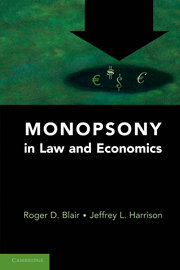Book contents
- Frontmatter
- Contents
- Preface
- ONE Introduction
- TWO The Antitrust Laws and Monopsonistic Forms of Conduct
- THREE Economic Theory of Monopsony
- FOUR The Antitrust Response to Monopsony and Collusive Monopsony
- FIVE Cooperative Buying Efforts
- SIX Bilateral Monopoly
- SEVEN Monopsony and Antitrust Enforcement
- EIGHT Monopsony in Action: Agricultural Markets
- NINE Monopsony in Action: The NCAA
- TEN Monopsony in Action: Physician Collective Bargaining: Monopoly or Bilateral Monopoly
- ELEVEN Final Comments
- Bibliography
- Index
ELEVEN - Final Comments
Published online by Cambridge University Press: 05 June 2012
- Frontmatter
- Contents
- Preface
- ONE Introduction
- TWO The Antitrust Laws and Monopsonistic Forms of Conduct
- THREE Economic Theory of Monopsony
- FOUR The Antitrust Response to Monopsony and Collusive Monopsony
- FIVE Cooperative Buying Efforts
- SIX Bilateral Monopoly
- SEVEN Monopsony and Antitrust Enforcement
- EIGHT Monopsony in Action: Agricultural Markets
- NINE Monopsony in Action: The NCAA
- TEN Monopsony in Action: Physician Collective Bargaining: Monopoly or Bilateral Monopoly
- ELEVEN Final Comments
- Bibliography
- Index
Summary
Introduction
Some twenty years ago, we began to incorporate monopsony into the general millieu of antitrust law and economics. Between then and now, we have continued that effort. In the preceding pages, we have attempted to summarize our work and that of others who have engaged in the same endeavor. The judicial understanding of and attitudes toward monopsony have become clearer in that time. Nevertheless, some uncertainties still remain. They can be traced to several issues discussed here. They provide the starting points for further research.
The Evolving Nature of Antitrust Law
Antitrust law itself is constantly evolving in something akin to the common law tradition. This means that the true status of what one might think are well-settled rules is uncertain. A good example is provided by United States v. Topco, the 1972 decision ruling that horizontal market division is per se unlawful. In that case, the defendants had a plausible procompetitive justification for market division that might well have survived a rule of reason analysis. If the case had been decided ten years later, it probably would have been subject to such a searching analysis. Thus, while many antitrust scholars think Topco was wrongly decided, the Supreme Court has not said so and, in fact, relied on it in a more recent opinion. Nevertheless, Topco involves the type of practice that may receive different treatment as antitrust evolves.
- Type
- Chapter
- Information
- Monopsony in Law and Economics , pp. 224 - 232Publisher: Cambridge University PressPrint publication year: 2010

